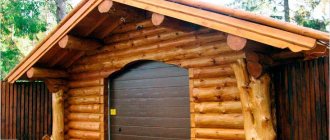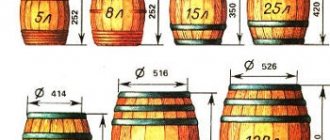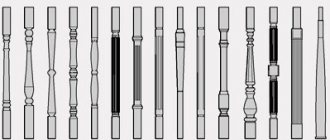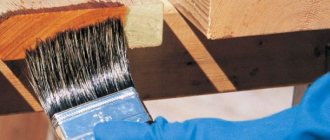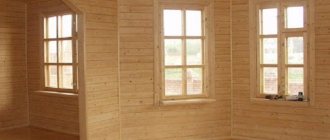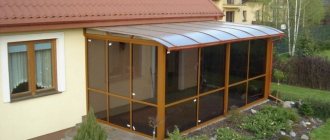Reinforced concrete rings, brick or wood are used to decorate the shaft of the well. Concrete structures are characterized by increased durability, but a high-quality wooden well is not inferior to monolithic parts. The logs or beams used must be impregnated with special compounds that prevent the material from rotting.
A wooden well is a beautiful design for a yard.
From timber or logs
The durability of a log structure depends on the type of wood that was used to make its elements. The owner of the land plot can use cylindrical or square-shaped elements that have been treated with antiseptic solutions and then dried in air. To construct a frame for a well, it is recommended to choose oak or pine that can withstand use for 25 years. Structures made of birch or linden, which have a low price, are destroyed after 5-10 years.
When selecting material, you need to pay attention to the density of the structure and the absence of cracks or knots. The outer surface of the parts should not have any traces of bark. It is forbidden to use elements damaged by insects, as the strength of the material and resistance to rotting are reduced. The logs or beams used in construction must have the same dimensions, without changing the cross-sectional area along the length (camber).
The purchased logs must have a moisture content no higher than 16% and not have a negative impact on the quality and taste of water. Coniferous wood has increased antibacterial characteristics due to the presence of organic resin. If you plan to use larch for construction, then you need to know that this material is characterized by increased resistance to moisture penetration into the deep layers, which increases resistance to rotting.
Staining technology for wood blanks
The staining procedure makes it possible to increase the resistance to rotting of workpieces made from oak or pine logs. The technology involves placing the material in running water. With gradual impregnation with liquid, the density of wood increases. After the blanks fall to the bottom, they are aged for another 6 months.
The stream washes tannins from the oak board, which spoil the taste of the water. The resulting material is characterized by 2-3 times increased resistance to decay in an aquatic environment.
A brief description of the sequence of actions when staining and processing workpieces:
- Mark the logs or beams. The length of the elements is selected depending on the size of the future well frame.
- Remove any remaining bark from the surface and then inspect the parts. Elements with cracks or knots are rejected.
- Dip the workpieces into water for impregnation.
- After completion of the staining procedure, mechanical processing of the parts is carried out. It is not recommended to dry the wood before cutting, as the strength of the material increases.
- Dry the finished parts to a moisture content no higher than 18%, and then begin building the log house. The elements are stacked in a cage and dried in a ventilated place. To prevent rainwater from entering and heating by sunlight, the parts are covered with a shield.
Bog oak boards.
Typical design of a wooden well
At the initial design stage, geodetic surveys are carried out on the land plot to determine the depth of groundwater. Then a rectangular shaft is excavated, and building material is simultaneously prepared. When calculating the number of logs, the depth of the shaft and the height of the head are taken into account. It is recommended to purchase materials in reserve.
When designing a log house, the following parameters are taken into account:
- side size is in the range of 1000-1700 mm;
- To make a log house, rounded logs with a diameter of up to 200 mm are used;
- when using square timber, the side size is 180 or 200 mm.
When developing a project, the method of connecting wood elements is taken into account, which allows us to draw up a list of fastening materials.
The configuration of the protective house covering the shaft opening and the lift gate is calculated. Based on the calculations, drawing documentation is prepared (indicating dimensions and tolerances) with an explanatory part, which provides step-by-step instructions for performing construction work. It is allowed to use ready-made projects, modified taking into account the depth of the well shaft dug on the site.
In a standard project, the head is filled with M100 concrete mortar to a depth of up to 1350 mm. The fill protrudes 150 mm above the ground surface, ensuring the drainage of spilled water. A concrete pad with a size of at least 1000 mm is evenly located around the perimeter of the head. The gap between the log house and the ground is filled with oily water-repellent clay, the layer thickness reaches 500 mm. The design uses a filter pad made of coarse river sand. It is possible to use gravel filler.
When is the best time to dig a well at your dacha?
If you hire a professional team from a reputable company, then you have no need to worry. Specialists with knowledge and experience, equipped with special equipment, will be able to complete the work without focusing on weather conditions and soil conditions. However, if you are going to do this work yourself, then it is very important to choose the right time for this.
- A favorable time for work is the time when groundwater is at its maximum depth.
- During this period, the water appearing at the bottom of the mine will show exactly the level of groundwater, which will then fill the well at the dacha and provide enough water.
- If it is the rainy season and high humidity, a non-specialist may mistake the surface water that appears in the mine for a ground aquifer, which can lead to insufficient water supply to the well and its drying out.
- Therefore, the best time to dig a well on a site is considered to be during a drought in summer, or winter, before the snow melts. However, in winter it is difficult to dig, since the ground freezes, and the air temperature is not very comfortable for excavation work.
- And the summer drought is an unstable period; rains can begin at any moment and the soil can become moist.
Experts recommend early autumn for digging a well yourself. There are many reasons for this:
- The harvest is almost harvested and digging the well does not interfere with the beds.
- At this time, there is no intensive gardening work and free time appears that can be devoted to digging a well.
- This is a time when there are no intense rains or frosts that could hinder work.
- The time is favorable not only to dig a well, but also to insulate, insulate the shaft, install a log house, gate or pump.
Sometimes it is recommended to carry out work in winter, before the snow melts. But we do not recommend this time, because in addition to the cold and frozen ground, it is very difficult to predict the onset of a thaw, and lately it very often begins earlier than expected.
Required tools and materials
The minimum set of tools required when constructing a well is as follows:
- devices for digging a well channel (bayonet and shovel shovels, pickaxe);
- steel scrap for breaking large stones or layers of rock;
- containers for excavating soil and pumping out liquid mud;
- a winch with a rigid base for lifting and lowering loads into the trunk;
- electric submersible pump that allows you to pump out water;
- circular saw for cutting workpieces (use of a chainsaw is allowed);
- a set of tools for marking workpieces;
- construction level (hydraulic or laser);
- axe;
- hacksaws for wood.
Tools for creating a wooden well.
In addition to a set of blanks for the frame and the head, it is necessary to prepare a set of fasteners (depending on the method of connecting the parts) and gravel for arranging the filter. Since the work is carried out in water or mud, it is necessary to use rubber boots or a wetsuit. Additionally, you will need to purchase insulated clothing.
Underground part
Selecting a location
Before starting construction, we need to understand whether it is possible to get to water on our site with acceptable labor costs, or will we have to install a decorative log house and get water from the main water supply or a well.
There are two ways to solve this issue:
- The safest thing to do is order a hydrogeological analysis of the site. Experts, having analyzed the location of the well site and carried out exploratory drilling, will be able to predict the depth of the upper aquifer, its capacity and the quality of the resulting water.
- This method has one significant drawback - its extremely high price. That is why, most often, owners of country houses simply interview their neighbors, asking at what depth the water lies in their wells and whether it is safe to drink.
It is important to find the place where drinking water lies closest to the surface
Note! When analyzing your neighbors' answers, you need to make allowances for differences in the height of your plots: it is quite possible that you will have to dig a few meters more or less just because of a slight difference in the relief.
However, if both options do not suit you, but you are sure that there should be water on the site, then you should try to get to it.
Wherein:
- It is best to dig a well in places where the relief is low - this way we will reduce labor costs for excavating large volumes of soil.
- If there are already cesspools or septic tanks on the site, it is best to locate the well as far as possible from them.
- Most often, the upper aquifers are tied to layers of clay, which acts as an aquifer, so the scale of future work can be assessed on nearby cliffs or on the walls of ravines.
Exploratory water drilling process
And yet, trying to find water without exploring and analyzing wells located in the immediate vicinity is a gamble with minimal chances of success. That is why, in such a situation, experts recommend building antique decorative wooden wells, which are a log house installed over a shallow pit.
Digging and arrangement
If there is water on the site and we have chosen a place, then we wait until summer and begin digging a well shaft. It is better to get to work during the dry period - this way we will not be disturbed by excessive soil moisture.
It is better to dig in the summer - this way the clay will not stick to the shovel
We dig a mine like this:
- We apply markings to the site under the well itself, as well as under the clay castle - an area around the perimeter of the source, which will protect the water inside from reverse filtration and precipitation through the ground.
- Then we start excavating the soil, going deeper by about 2 - 2.5 m. If the set of parts for the log house is already ready, then we install the lower crowns in the hole, after which we begin to deepen it, gradually increasing the log house from above.
Important! The methodology for preparing parts and assembling a log house will be described in the corresponding section.
- We continue this way until we reach the aquifer and go deep into it. Since we carry out the work in the summer, the water level will be extremely low, which means that throughout the year the water will be much higher and we will have a sufficient supply of liquid.
- If water accumulates in the hole, it will have to be scooped out. In this case, we use a thick wooden box to deepen it: we place it on the bottom, select the soil from the inside and lower the box below. We repeat the operations until the desired depth is achieved.
Shield-cover made of aspen for installation on top of the gravel filter
After this, we arrange the filter: we fill the bottom with coarse sand, gravel and coarse crushed stone in layers. If necessary, we place a disk of loosely knit aspen boards on top of the gravel filter - such a wooden cover on the well will reliably protect the hearth from silt and soil particles.
Do-it-yourself technology for making a log house for a well
To make a well frame from wood, 3 methods are used:
- erection of a structure from the bottom of the well;
- making a log house by lowering the crowns into the ground;
- building up a log frame from below using spacer elements.
Technology for lifting a log from the bottom
The well trunk is dug until it goes deep into the aquifer. The degree of penetration depends on the thickness of the soil layer saturated with liquid.
Under standard conditions, the trunk is lowered to 50% of the layer or until the waterproof plane is reached. If there are areas with loose soil in the lower part of the trunk, then it is strengthened with the help of stone slabs. Then the logs of the base of the log house are laid on the bottom, which are covered with boards (placed with a gap).
The sequence of actions when building a log house from the bottom of a well will be as follows:
- Cut logs or beams into pieces of length in accordance with the project. There are no protrusions allowed on the edges of the parts that will cling to the ground when arranging the log house. If there is bark on the surface of the workpieces, it is cut off with an ax or plane.
- Assemble several tiers of the future log house on the ground surface. Locks are placed on the end parts of the elements. The technique allows you to maintain the perpendicularity of the structure. Control is carried out at the building level. Since the technology for constructing a log house does not provide for sealing cracks with special materials, the mating planes of logs or beams are adjusted to the installation site.
- Mark the beams and move the structure to the bottom of the well. When laying wooden elements, it is prohibited to use metal hammers or sledgehammers, which will split the material.
- As the height of the log house increases, it is necessary to fill the gap formed between the log structure and the ground surfaces of the trunk with clay. Clay reduces the rate of wood decay and protects the internal cavity of the trunk from foreign impurities.
Assembling a log house using the lowering method
Decoration of a wooden well.
If the depth of the aquifer exceeds 5 m, then the method of digging out a trunk and then installing a frame is not used due to the danger of blocking the well with soil. In this case, a niche up to 4 m deep is dug in the area, into which a log structure is installed. The technology for preparing a log house does not differ from that described above. A starting ring is placed at the bottom of the pit, which is set horizontally using spacer wedges. To check the position of the structure, use a hydraulic or laser level.
The installer assembles the frame until a head is formed, which has a height of 3-5 crowns. Then a hole is dug in the central part of the trunk to a depth corresponding to the height of the log or timber used.
4 niches are dug out, located in the center of the side walls of the log house. Stops made of logs are placed in the niches, after which the remaining soil in the corners is removed. Then the installer knocks out stops on opposite sides, ensuring that the log house settles into the shaft by 1 crown.
After the resulting head goes into the well shaft, it is expanded again. The log house is lowered until the aquifer is reached, then the liquid is pumped out, and the structure is lowered another 2-3 crowns. It is recommended to deepen the log house until a dense waterproof layer is reached. The bottom of the well is equipped with a box made of timber or boards, which rests on the lower layer of soil.
How to build up a log house from below
The technique of constructing a log house by lowering has a disadvantage associated with the violation of the vertical position of the structure. Logs cling to soil walls, which leads to jamming of the wooden structure and disconnection of locks.
This technique is based on layer-by-layer increasing the height of the structure with logs installed at the bottom of the log house. The design includes safety elements that prevent spontaneous settling of logs into the well shaft.
The sequence of actions will be as follows:
- Assemble a frame of 4-6 crowns on the ground surface. Ensure tight contact between the elements and make locking connections.
- Label the parts. The structure is lowered into a pre-dug hole. Then a crown is formed from below, assembled from 2 side elements with a length increased by 600-700 mm. The ends of the logs are embedded in the soil walls of the well shaft, providing support for the upper part of the frame.
- Install the next section of a wooden structure of 5 crowns, assembled from parts with a standard length.
- Install a thrust layer of elongated beams, which are located perpendicular to the previous supporting platform.
- After reaching the aquifer, the lower part of the well trunk is formed. The design consists of 3-5 crowns of logs with increased length, which ensures the stability of the entire log house.
- Make a support box from a wooden profile, which is placed at the bottom of the well and goes deep into the ground until it stops.
Another option for a wooden well.
Wood for logs properties, characteristics
Monolithic or prefabricated reinforced concrete well shaft is widely used nowadays. If relatively recently, 30-40 years ago, well log houses were entirely wooden and made of durable wood, but now reinforced concrete well rings can simply be equipped with timber and other materials on top. Skilled craftsmen previously lined wells with stone slabs. One of them, built at the end of the 19th century, with a depth of more than 35 meters, functions to this day, without drying out even in the driest periods. It is impossible to say that all owners have become adherents of reinforced concrete structures. Many owners choose log houses for wells, log houses for wells made of wood:
- The wood should not rot or release substances that could spoil the taste and color of water for a long time.
- Have a certain density, strength and not have large knots.
- Logs prepared for felling must first be well dried.
Attention: A prerequisite for making a wooden log house is dry wood; subsequently, swelling from water, it increases in volume and all the grooves and cracks of the log house are naturally sealed.
- Without competition, bog oak is used for felling; the water in such wells is of high quality, and the service life of the well reaches 40-50 years.
- The wood for the well is made from ash, beech, and elm, which is also quite durable, water-resistant, and does not change the taste of the water. However, the surface part of the log house, made of these materials, quickly rots in humid conditions, although being completely in water, it feels great.
- Wood such as pine, cedar or larch are excellent materials for building a log house. The service life of wood reaches more than 30 years in the underwater and above-water parts of the structure, without compromising water quality.
Simple observations collected in a table from the practice of operating wooden wells will help you choose the right wood for your log house.
| Name of wood | Duration of operation, years | Negative impacts that degrade water quality | Prone to rot | ||
| Under the water | Above the water | Taste | Color | ||
| Willow Birch Elm | 810 20 | 5 | No | No | No is rotting No |
| Common oak | 25-35 and more | 20-25 | bitter | brown | No |
| Pine, aspen | 15-20 | 5 | bitter | No | No |
| Alder | 20 | 5 | No | No | is rotting |
| Larch | 25 or more | 20 | No | No | No |
| Bog oak | 40-50 or more | 50 or more | No | No | No |
Note: The bitter taste that common oak, pine and aspen gives to water disappears over time.
- A log house made for a well from willow, spruce or birch wood has an indecently short service life, only 5-7 years. They have found their application in small wells and how the superstructure of the upper part and the lower part of the frame are necessarily made of durable, waterproof and strong wood, straight, healthy, without traces of rot, made not from dead wood, not damaged by bark beetles and not having a wormhole.
- The price of a combined log house, when the wood of beech, elm, ash is put down, and the top is made of pine, oak or larch, is more attractive to consumers.
How to assemble a log house correctly
When assembling a log house, it is necessary to ensure a tight connection of the elements within each crown. Rows of logs are installed perpendicular to the ground surface. To adjust the position, trimming the surface of the parts is allowed. The strength of the structure and the quality of the water that will collect in the lower part of the well depend on the correct assembly of the log house.
Corner connection of crowns
To connect the crowns, 2 methods are used:
- joint “in the paw”;
- half-tree pairing.
When joining “in the paw”, rectangular recesses are cut out in the logs, in which there are protrusions and response cavities. The connection design is characterized by increased rigidity, but is rarely used due to labor intensity.
The dovetail joining technique requires careful marking of surfaces, but provides high tensile and torsional strength. There is a combined connection scheme in which a spacer wedge is inserted into the contact zone, further strengthening the structure.
Assembling a well frame.
The technology for joining half-timber elements involves making rectangular cutouts on mating logs. Grooves are made at the ends of the parts at 50% of the cross-section; the planes undergo additional mechanical processing to reduce gaps.
The crowns are connected to each other by round pins, which are driven into pre-prepared holes. The design is not complicated, but the rigidity of the frame is insufficient for use in a well shaft. To build a log house, it is recommended to use the dovetail connection technology.
To cut dovetail joints, a special template is used, which allows you to obtain slots of the same configuration. To ensure the tightness of the joint between the crowns, a semicircular niche is cut out in the body of the lower logs, into which the upper row of elements is placed. When using timber, a square groove is cut out on the parts, into which a counter tenon, formed on the upper crown, fits.
How to make a wooden well with your own hands
A brief sequence of actions when arranging a well with a wooden trunk trim is as follows:
- Purchase ready-made logs that have gone through a staining cycle, or process the material yourself. In the second case, it should be taken into account that the procedure for impregnating beams or logs with water and subsequent drying takes up to 2 years.
- Conduct geodetic surveys and determine the location of the well. When using oak or larch beams (logs), a well depth of up to 15 m is allowed.
- Start digging a niche with the subsequent installation of a log house. Since work is carried out in deep soil, safety regulations must be observed. The installer wears a hard hat. To hold the log structure, a winch is used, mounted on a base with sufficient strength. When in a well shaft, it is recommended to use an air gas analyzer or a burning candle, which will warn a person about a drop in the volume fraction of oxygen in the air.
- Fill the shaft to the required depth with wooden elements. When the aquifer is reached, a pump goes down, allowing the lower crowns to be mounted and the base box to be positioned.
- Form a gravel or sand filter.
- Build a head on which the gate and protective cover are mounted. For additional protection from debris, a gable roof is installed, raised above the upper edge of the cap by 1000-1500 mm. If you plan to use an electric pump, then the unit is mounted inside the shaft. A distribution valve is placed on the side plane of the head.
- Remove soil at a distance of 1-1.5 m around the channel with the installed frame. Fill the cavity around the wooden elements with water-repellent clay, and then fill it with M100 grade concrete.
We follow safety precautions
All work must be carried out in compliance with safety regulations. This is useful to read and the most important thing to do is:
- You should always check the well before going down for the presence of gas. To do this, just light a splinter and throw it down. If the splinter starts to burn stronger, then this will be evidence of the presence of harmful gas.
Attention: Nowadays there are even gas analyzers that detect the presence of gas in the pit. If you are thinking of doing this professionally, then it makes sense to buy it.
- If there is gas, the descent is strictly forbidden. It needs to be removed. This is done using a compressor or fan;
- When descending into the pit, you must wear a helmet. A stone may also fall from above. Take this seriously;
As can be seen from the above, everything can be done. And such a design will be quite original. The guests will all just go on excursions.
How to make a gravel filter at the bottom of a log house
The groundwater entering the storage niche of the well contains particles of sand and clay that need to be filtered. Granite crushed stone or river sand is used to separate foreign impurities. To improve the quality of cleaning, it is recommended to take material from several fractions. The bottom layer has a thickness of up to 100 mm. To form the formation, stones ranging in size from 10 to 20 mm are used. The resulting layer is compacted manually, which improves filtering properties.
The middle layer is made of granite crushed stone with a size of 20-80 mm, the layer thickness is 140-160 mm . Then a finishing layer up to 200 mm thick is laid, which consists of gravel up to 100-120 mm in size. After installing the filter, you need to wait a few days to purify the water. The liquid will be cloudy and should not be used for drinking. It is allowed to pump out water for irrigation or other technical purposes. As the wood swells and impurities settle, the water becomes clear and suitable for cooking and drinking.
Wooden well head
Wooden well head.
The part of the log house protruding above the ground surface has a height of 700 to 1500 mm. To build the head, logs or beams identical to those installed in the trunk of the well are used. The design prevents dust and fallen leaves from entering the water, and is also used as a base for attaching the gate.
There are no requirements for the external design of the head; The owner independently develops the design of the building. It is recommended to include a sealed removable or hinged cover into the assembly design, which additionally protects the barrel from debris.
Gate supports are made of beams or symmetrical logs with forks. The structure must support the weight of the lifting mechanism, chain and bucket of water. The gate is equipped with a metal axis, which is installed in steel or bronze bushings that reduce friction.
A steel handle is used to rotate the winch. The hand grip area is covered with a plastic cover that prevents the skin of the hands or the material of the gloves from freezing at subzero temperatures.
Additional protection is placed above the supports in the form of a house made of boards or tiles. The design of the head provides for an exhaust duct that provides ventilation to the well shaft. Risers are made of metal or plastic pipes. A protective mesh is installed in the channel.
Continuous air exchange has a positive effect on water quality and reduces the rate of formation of growths on the inner surface of a log frame.
Operating rules
During the operation of a log house, a layer of moss and mold forms on the inner surface, which contributes to the destruction of the wood. It is recommended to periodically inspect the well shaft. Before starting work, the water level is reduced to a minimum (for example, using an electric pump). A special platform made of boards is lowered into the trunk, which is raised and lowered using a standard gate or winch. The specialist examines the surfaces, identifying damaged joints between logs through which liquid leaks into the ground.
A metal scraper is used to remove accumulated dirt. Since the crushed stone laid at the bottom of the well is also subject to contamination, it is removed to the surface for cleaning and washing. The gravel is then placed on the bottom. Detected cracks are repaired using wooden elements, which are driven in with a mallet. When the well is filled with water, the inserts will swell, ensuring the tightness of the log house.
Completely destroyed beams must be replaced with new ones. To perform the work, you need to install a tripod with a lifting device over the well.
Then water is pumped out of the trunk and rotten elements are removed. New ones are inserted in place of the removed beams, then the upper part of the frame is lowered onto the replaced crowns. Using this technology, it is possible to completely or partially replace a log house assembled from rectangular elements.
Design of the above-ground part of the log house
To protect the well from rainwater entering it, a clay castle is made around the log house. This creates a slope from the head outward. It will be possible to concrete the area around the well only after 2-3 years, when the soil has finally settled.
Decorate the outer part of the log house to your liking. A common method is to install a gate and a roof over it. The gable roof protects the water in the well from rain entering from above.
In the northern regions, to conserve water in winter, a booth is made around the head of the log house. This is a small enclosed room made of boards that prevents snow drifts near the gate. In severe frosts, the mouth of the well is additionally covered with a thick plank lid.
The decorative finishing of a lifting mechanism, canopy or house depends entirely on the tastes and skills of the owner. You can design a well frame in the old Russian style, with carved columns and figured roof overhangs, or in a modern, technological style, using metal to make gates and roof supports. Transparent plastic or ondulin is suitable as a roofing sheet.
The hard and complex work of building a well yourself will be rewarded with the opportunity to obtain water without the smell of disinfectants. Fans of a healthy lifestyle call this water alive and consider it very beneficial for the body. Whether this is true or not will be decided by the craftsman who will be able to organize his own source of fresh water on his site.
